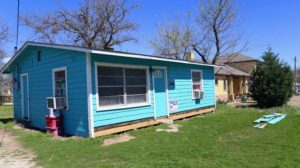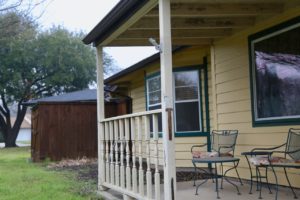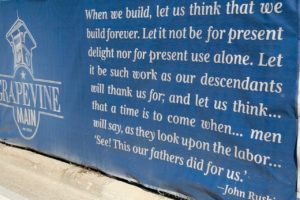We Build Forever – Maintaining Community in the Booming City of Grapevine
GRAPEVINE — High above the Grapevine City Council chamber, carved into the wall where sitting officials cannot hope to miss it, sits the John Ruskin quote that has come to define the city’s policy:
“When we build, let us think that we build forever. Let it not be for present delight nor for present use alone. Let it be such work as our descendants will thank us for; and let us think, as we lay stone on stone, that a time is to come when those stones will be held sacred because our hands have touched them, and that men will say, as they look upon the labor and wrought substance of them, ‘See! This our father did for us.”
While it may not have been the official slogan of her first bid for office in 1998, Grapevine Mayor Pro Tem Darlene Freed has taken the saying to heart. What began with a citizens’ petition to reduce traffic in her residential neighborhood has become a decades-long career in local politics. At the heart of Freed’s involvement: a desire to keep the booming city of Grapevine open to anyone and everyone.
To that end, she’s been working to bring the Community Powered Revitalization (CPR) program to the city for years. It will officially launch in Grapevine on April 5, 2019. And if you ask her why that matters, she can point to the exact neighborhoods where lives are going to change.
“Victims of Our Own Success”
Freed slides into the driver’s seat of our pickup truck with the comfort and confidence of a longtime resident. A native of California, she and her husband moved to Grapevine in 1983. Working from a memorized list of homes awaiting repairs during the upcoming CPR event, she navigates from one site to the next without any assistance. She knows these roads. She can’t imagine any others feeling like home.
“Grapevine is an old, old city. Actually older than Fort Worth. When we first moved [here], downtown Main Street was pretty much dead. There was not much going on,” she said, pushing the accelerator and guiding the truck down the now-crowded tourist center of the town and away from City Hall. “Little did we know, between the airport and Gaylord, that we’d become such a tourism Mecca like we’ve become today.”

In Grapevine, historical properties like this one are often sandwiched between larger, more modern homes.
Main Street falls away behind us and the roads get rougher. Elaborate brickwork shifts to wooden paneling. Homes slide passed us as we turn into the first neighborhood; some recently built or renovated. Others held in place and time for more than fifty years.
“We’re sort of a victim of our own success. I mean you create a good historic district that has a lot of value and you do create a situation where the prices go up and up,” Freed said. “The mayor and I have had several conversations about this. We can’t forget the people that have lived here a long time that — maybe their house is worth a whole lot more than they ever paid for it — but they can’t really afford to move or go anywhere, and they don’t have the ability to do the things that need to be done to keep their house out of disrepair.”
We pull up to the first home on our list and pause. It’s a humble property; under 500 square feet in total residential space. On one side: another simple home built in the time before commercial air travel. On the other? A two-story property with immaculate landscaping.
“That’s Not Community. That’s Not Grapevine.”
While there’s evidence of Grapevine’s shifting identity all around town, it’s most clear in the historic district, where property values have skyrocketed as tourism takes hold. The city has intentionally moved some of its older estates into this area to maintain them, but many of the homes are original. Lots of the owners are, too.
“You could probably bulldoze every one of these houses and put in a half-million dollar house if you wanted to,” Darlene said. “But that’s not what a community is about. That’s not what Grapevine is about. Most of these people have lived in these houses for 40 or 50 years… this community belongs to them as much — if not more than — anybody. [Them] knowing that they’re important to us and a part of our community really matters.”
City leaders have labored to fuse the old and the new into a single identity for Grapevine; to create a community that feels warm and historic, but also modern and functional. Guided by that principle, they’ve battled to keep rising costs and changes in Quality of Life resources from driving any particular set of residents away. The town’s new Senior Center shares a property with its Recreational Facility, melding the elderly and the young into one landscape. The same approach applies to citizens with different economic backgrounds.
“There’s a lot of jobs in and around Grapevine,” Freed said. “To make sure that all of those folks — whether you’re the executive at a Gaylord or a server in a restaurant or a person washing dishes — for me, I want all of those folks to be able to live and be a part of this town. That, to me, is what community is all about. That’s one of the reasons why I think 6 Stones is so important: to make sure that we keep these folks here and make sure we keep these houses in as good a shape as we can.”
“What You Do With Suffering”
We make our way through the winding streets of a community that never expected to become what it is, and I marvel at the patchwork neighborhoods we explore. Some streets feel like they were settled only yesterday; others as though they were built all at once, three-quarters of a century ago. But the infrastructure — like the people of Grapevine — is a mosaic that seems to shift each time we pass a mailbox. Impossibly, though, the overall tone never changes. Every house, from the most diminutive to the most impressive, is truly a Home.
We make our way back to Main Street, the strip of old landmarks and colorful storefronts that define both the iconography and identity of Grapevine. I venture the last lingering question I can think to ask: Why fight for this? Can we really do something about the need here? What good does it do for citizens and civil servants to volunteer through CPR?
Freed nods and gives a half-smile. This is personal.
“The only way you get through pain or any suffering in your life is to do something for someone else. I discovered that when I lost my Mom to Alzheimer's. I’ve spent a lot of time since then trying to help others that have had to go through that as caregivers,” she said. “It’s such a big blessing. I just think we all have so much, and if we just live and enjoy what we have without doing things to help other people, I don’t know what the point is.
“Life is really sort of suffering and what you do with that suffering. What you decide to make better for someone else. That is what matters. And I think Grapevine, overall, has a spirit of that in our community; in our churches and our civic organizations. This is just another layer of being able to do that. It’s pretty great to be able to do it.”
She laughs and wonders aloud: “Was that too deep?”
In the stillness behind the camera, I smile back. Not at all.
In fact, that’s what we’ve always wanted: to serve the most deserving and at-risk people in our community, yes. But also to remind the rest of us that a Community is more than its buildings and roads. It’s the spirit of a place. The way people come together, and their attitudes as they do. It’s an intentional fusion of elements that are stronger in unity than in isolation.


